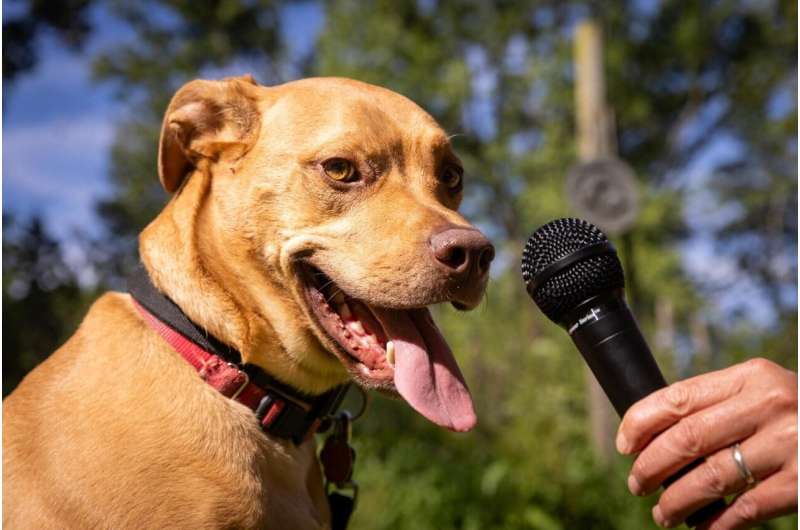This article has been reviewed according to Science X's editorial process and policies. Editors have highlighted the following attributes while ensuring the content's credibility:
fact-checked
preprint
trusted source
proofread
Using AI to decode dog vocalizations

Have you ever wished you could understand what your dog is trying to say to you? University of Michigan researchers are exploring the possibilities of AI, developing tools that can identify whether a dog's bark conveys playfulness or aggression.
The same models can also glean other information from animal vocalizations, such as the animal's age, breed and sex. A collaboration with Mexico's National Institute of Astrophysics, Optics and Electronics (INAOE) Institute in Puebla, the study finds that AI models originally trained on human speech can be used as a starting point to train new systems that target animal communication.
The results were presented at the Joint International Conference on Computational Linguistics, Language Resources and Evaluation. The study is published on the arXiv preprint server.
"By using speech processing models initially trained on human speech, our research opens a new window into how we can leverage what we built so far in speech processing to start understanding the nuances of dog barks," said Rada Mihalcea, the Janice M. Jenkins Collegiate Professor of Computer Science and Engineering, and director of U-M's AI Laboratory.
"There is so much we don't yet know about the animals that share this world with us. Advances in AI can be used to revolutionize our understanding of animal communication, and our findings suggest that we may not have to start from scratch."
One of the prevailing obstacles to developing AI models that can analyze animal vocalizations is the lack of publicly available data. While there are numerous resources and opportunities for recording human speech, collecting such data from animals is more difficult.
"Animal vocalizations are logistically much harder to solicit and record," said Artem Abzaliev, lead author and U-M doctoral student in computer science and engineering. "They must be passively recorded in the wild or, in the case of domestic pets, with the permission of owners."

Because of this dearth of usable data, techniques for analyzing dog vocalizations have proven difficult to develop, and the ones that do exist are limited by a lack of training material. The researchers overcame these challenges by repurposing an existing model that was originally designed to analyze human speech.
This approach enabled the researchers to tap into robust models that form the backbone of the various voice-enabled technologies we use today, including voice-to-text and language translation. These models are trained to distinguish nuances in human speech, like tone, pitch and accent, and convert this information into a format that a computer can use to identify what words are being said, recognize the individual speaking, and more.
"These models are able to learn and encode the incredibly complex patterns of human language and speech," Abzaliev said. "We wanted to see if we could leverage this ability to discern and interpret dog barks."
The researchers used a dataset of dog vocalizations recorded from 74 dogs of varying breed, age and sex, in a variety of contexts. Humberto Pérez-Espinosa, a collaborator at INAOE, led the team who collected the dataset. Abzaliev then used the recordings to modify a machine-learning model—a type of computer algorithm that identifies patterns in large data sets. The team chose a speech representation model called Wav2Vec2, which was originally trained on human speech data.
With this model, the researchers were able to generate representations of the acoustic data collected from the dogs and interpret these representations. They found that Wav2Vec2 not only succeeded at four classification tasks; it also outperformed other models trained specifically on dog bark data, with accuracy figures up to 70%.
"This is the first time that techniques optimized for human speech have been built upon to help with the decoding of animal communication," Mihalcea said. "Our results show that the sounds and patterns derived from human speech can serve as a foundation for analyzing and understanding the acoustic patterns of other sounds, such as animal vocalizations."
In addition to establishing human speech models as a useful tool in analyzing animal communication—which could benefit biologists, animal behaviorists and more—this research has important implications for animal welfare. Understanding the nuances of dog vocalizations could greatly improve how humans interpret and respond to the emotional and physical needs of dogs, thereby enhancing their care and preventing potentially dangerous situations, the researchers said.
More information: Artem Abzaliev et al, Towards Dog Bark Decoding: Leveraging Human Speech Processing for Automated Bark Classification, arXiv (2024). DOI: 10.48550/arxiv.2404.18739


















